
The entrance to the ice hotel. Ice pillars and an ice chandelier.
Easter 2000 Ellen and I crossed the arctic circle for the first time.
The highlights of our trip were a visit to the Ice Hotel and to the caves near Bjorkliden.
The Ice Hotel
First stop was Kiruna Sweden where a shuttle took us to the ice hotel, a hotel entirely made of snow and ice. We hoped for sun since Håkan said that sunlight penetrated the ice illuminating the interior of the hotel in wonderful ways. We had sunlight, Håkan was right!

Inside the entrance to the ice hotel the chandelier was made of ice and illuminated with fiber optics. Clear ice blocks made pillars to help support the roof.
Deeper inside we found two thrones carved from ice for the King and Queen of Sweden. We sat in them, of course.

Throughout the hotel artists had carved whimsical scenes from ice. In this Christmas scene the fireplace had ice logs with burning candles behind them. The ice chairs are covered with reindeer skins. which do a great job insulating asses from cold and wet.

There was an ice bar where the glasses were made of ice...whiskey in the rocks. And an ice chapel. The artists had used clear ice blocks as light pipes to make a cross set into a snow wall. During the day the ice was sunlight bright against the dark snow, as the sun set the ice became dark and the wall became brighter in contrast so that there was a dark cross against a white snow wall.
The artists of the hotel are masters of light. There were over a dozen suites each of which was carved by an artist, the ice carvings were amazing: dragons, Viking ships, abstract pieces flowers frozen into blocks of crystalline ice and more surrounded the beds. When you sleep in the ice hotel you sleep in Swedish army issue arctic sleeping bags, on reindeer skins, covering 10 cm of foam, over a wooden frame built on ice. Lights under the bed shine through the ice.
It is called the ice hotel but it is also a light hotel.
The Caves of Bjorkliden
Bjorkliden is a Swedish ski resort just north of Abisko National Park. On our second day there, Ellen and I signed up to go on a snowshoe tour to visit one of the longest caves in Sweden. (In 2000 the tour ran once a week at 7 PM on Friday nights.)
At 7 PM we joined our guide Bjorn Åström and 8 other people.
We put on the small modern plastic snowshoes. They had ice-creeper points on the bottom, crampon points on the toe of the binding, and heel-lifts so you could walk up steep hills without stretching your Achilles tendon.
We hiked uphill an hour and a half from the lodge across ski slopes and through birch forests. (The bjork in bjorkliden is Swedish for birch.) As we got close to the caves Bjorn had us take off our snowshoes and put on helmets and headlamps. The cave entrances were hard to spot, they were small holes along the bottom of the north cliff of a stream valley.

Bjorn rigged up a rope from a tree above one of the entrances, the rope was there to help us get out of the slippery snowy entrance, but we used it to ease our entrance too.

After sliding down on snow we came to walking passages lined with frost and ice. The crystals sparkled in our headlamp light.

The walls were made of schist. The strangest material for cave walls I ever did see. Evidently beneath the schist there is marble and the cave continues down into the marble layer. But to get there it cut through the black schist striped with white crystal bands. Beyond the mouth of the cave the air warmed up and the frost disappeared to be replaced by water. We were glad to have our goretex coats and pants as well as gloves to protect us from the cold film of water that covered almost everything..
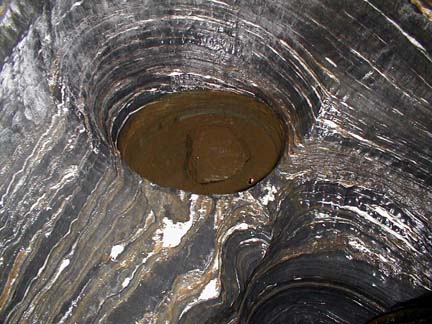
After a hundred yards or so we reached crawling passage which continued for another kilometer. At this point we turned around and returned to the surface. Ellen and I took our time on the way out enjoying peeks down side passages, speculating how our friend Martin would have joyfully squeezed off to explore them.
Too soon, we were back at the entrance. The rope was a big help getting up the slippery snow slope to the surface.

We had a great time as you can see by Ellen's smile.
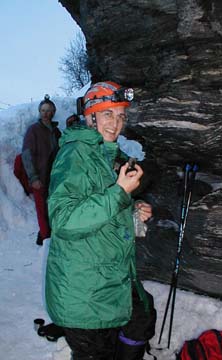
We put on our snowshoes and returned to the hotel by 11 PM. It was still light! It was late April and we were far north of the arctic circle at 68 degrees north latitude, what a place to go caving.
Skiing up to Låktatjåkko
There were other adventures at Bjorkliden. The last day, I headed up to the Låktatjåkko hut 1200 meters above and 9.5 km from the hotel. I couldn't leave until 8:15 AM and I wanted to beat Ellen to the hut (she was riding the cat, known in Sweden as a bandvagn). I dressed lightly and moved fast. There was a lot of uphill, as I worked up the trail, I kept thinking of how much fun I would have on the way down. Dark rocky mountains peaked out of the snow and clouds all around me. Thankfully, there were no snowmobiles this early. I reached the hut by 10:30 and the cat arrived at 11:00. Just as Ellen arrived the sky cleared of clouds.
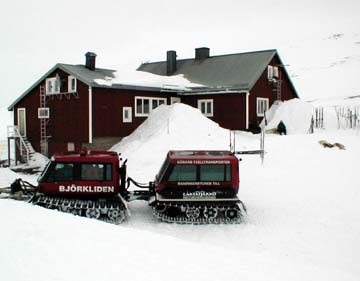
I was still hot from my ski up so I threw on a light coat and ran out to meet Ellen in the sunshine. Behind me is a view toward Narvik, Norway.
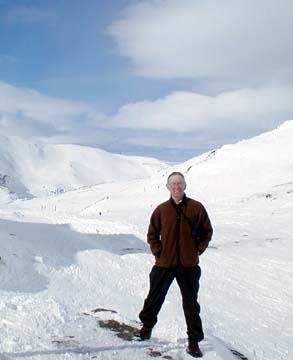
Before we skied out, we ate at the hut. The chef cooked us a great Reindeer stew which we followed with plates of waffles, berries and cream. The hut also had a warming room where I dried my ski gear. There were beds at the hut and the next time I'd be tempted to ski up and stay a couple of days, especially with the great food we were served for lunch. We left the hut looking for adventure and found it. We contoured to the south and east skiing along the summer hiking trail. Thankfully, this kept us a way from the snowmobiles which clogged the regular trails as a snarling horde. As we skied we encountered several icy spots and places which had me checking for avalanche danger. Eventually we came to an interesting cliff band which was made of black schist with bands of white crystals. It began to blow and snow.
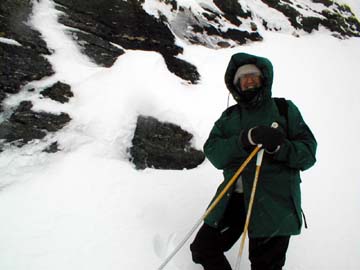
The snow began to pick up, clouds started to swirl around and the visibility deteriorated rapidly, time to return to the hut.
I followed the rock cairns and we made it safely back. In the face of the worsening conditions, I decided to leave right away for the hotel, and to follow the well marked main trail rather than the unmarked scenic route. This was a good choice on my part.
The wind was blowing icy snow into my eyes but at first I could see the red poles easily. The poles are placed every 10 meters or so along the trail. I skied safely down the first seep hill and made good time after that. The bandvagn caught up to me and I got to wave at Ellen as she passed. Then the conditions went from bad to awful. Visibility dropped to 10 meters. From one pole I could just barely see the next pole. It was snowing hard enough that drifts covered all traces of the track. I really had problems when one of the poles was missing or buried. Then I would have to ski out into a sea of white hoping to spot another pole. Once I skied out and found no pole. I started a search circle and after a few tense minutes picked up a pole. Whew. As tough as it was the last time this happened on my trip to Norway, then at least I had companions, this time it was harder probing the whiteout alone. At one point I put on my ski goggles which kept the ice crystals from blowing into my eyes, but without my prescription I couldn't see well enough to spot the poles so I quickly returned to my glasses. Once more I felt lost, this time I could see a few poles but what I could see did not look like the trail I remembered on the way up. I pulled out the GPS which I had used to record my route in the morning and found that indeed I was not on that route but on a parallel route made for snowmobiles. I pushed on along the trail and soon saw the hotel. Later that night I met Bjorn our guide for the cave adventure he said that the trail down was dangerous in a whiteout due to small cliffs that line the route. He also told me that just the day before a skier had died on the very trail I was following. It was a freeak accident, in a whiteout he had skied into a stopped snowmobile, fallen forward struck his head and died. A cautionary tail for whiteout skiing.